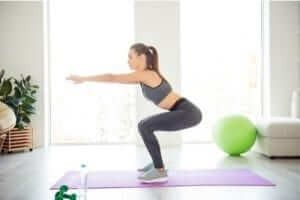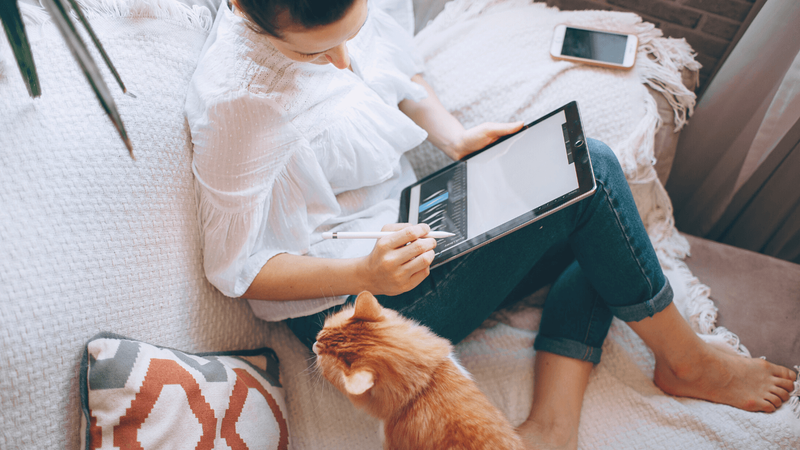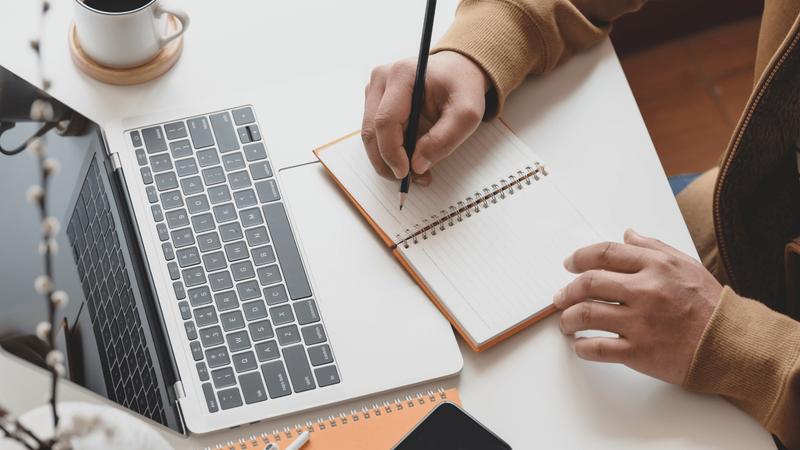7 Simple Exercises to Do at Your Standing Desk

Much has been said about the benefits of standing desks for your health, but in reality, they are only a part of the puzzle to a healthier desk routine. The key is to ensure you’re not stuck in the same working position for too long at a time.
Standing too long can cause blood to pool up in veins in the lower leg, leading to conditions like varicose veins after a long time. Excessive standing has also been linked to muscle fatigue and strain in the legs, according to Webmd. The takeaway from this is that our bodies aren’t designed to be in the same position for too long—whether sitting or standing.
With that said, if you currently use a standing desk for work, moving your body periodically is critical. And for that, here are 7 simple exercises you can incorporate into your daily desk routine for better health and productivity.
1. Bodyweight Squats
One of the best and easiest exercises you can do while standing is the squat. Squats are a versatile, compound exercise that works out several muscle groups in the legs and core. It improves circulation and posture, and is great for the lower back.
There are so many variations of the squat you can try. For classic squats, it is important that you maintain good form. The back should be flat, and most of your weight should be on the heels and not on your toes. Your knees should be behind your toes during the squat.
Hold the squat position for as long as possible for one set. Do a minimum of 3 sets.
2. Lunges
Lunges are another classic compound exercise for the lower back and legs. Like squats, there are many variations—classic lunge, reverse lunge, curtsy lunge, etc. It works out important muscle groups in the lower legs.
Like in squats, the back should remain neutral with no arching. Some variations like the curtsy lunge use a greater range of movement, and are even better than the classic lunge.
In the classic lunge, you bring one leg forward and keep the other back. As you do this, you bend both knees so that your upper leg and lower leg form right angles to each other.
Come up and alternate between legs for at least 5 times for one set.
3. Calf Raises
Calf raises are the most accessible exercise you can do at a standing desk, as they require very little space. They work muscles in the calves and strengthen the lower leg muscles and ankles. They improve posture and stability.
For a simple bodyweight calf raise:
- Stand straight with your feet shoulder-width apart.
- Slowly raise your legs and transfer all your weight onto the ball of your feet.
- Your legs should be straight during the exercise.
- Hold this posture for a minimum of 10 seconds.
- Repeat this 5 times for one set.
4. Standing Leg Raises
A standing leg raise is another simple yet incredibly effective exercise to do at a standing desk. They are versatile and there are many variations of it—side leg raises, front leg raises, etc. They require very little space and no equipment, so are ideal to do at a standing desk.
They work muscles in the hips (hip abductor muscles), core and legs. They will help strengthen leg muscles and significantly improve your balance.
The key to doing these properly is to move your leg slowly and not allow it to swing. Doing it slowly will work your muscles more. Try to ensure that each leg raise lasts about 30 seconds before switching sides.
5. Standing Knee Touches
Standing knee touches is one of the best standing ab exercises. They really work your core and they also improve your balance and stability.
There are many variations you can do as well. You can do diagonal knee touches (right elbow touches left knee), for example.
To do a standing knee touch:
- Stand straight with your feet flat on the ground
- Bend one knee and bring it forward to your chest
- Touch your bent knee with your elbow.
- Repeat with the alternate leg
- Repeat this 5 times for one set.
6. Standing Side Bends
Standing side bends are an amazing standing ab exercise. They are great for your core and back. They almost feel more like a stretch than a proper ab exercise.
They don’t require a lot of space either. They are very versatile with plenty of variations to help you switch things up. You can add light dumbbells to increase the difficulty later on.
They work your oblique ab muscles (the ab muscles on the side of your core) as well as the spinal erector muscle. The spinal erector muscle is the long muscle that runs down your spine, and is responsible for stretching and rotating your back.
To do this,
- Stand straight with your arms raised above your head
- Bend to the side as much as you can while maintaining your balance
- Repeat by bending to the other side
- Complete 5 bends for one set.
7. Standing Toe Touches
This is a very common stretch found in yoga, and one of the best exercises to quickly relax your back.
- Stand straight with your feet together
- Bend down as far as you can while keeping your legs straight and back relatively straight
- Try as much as possible to touch your toes
- Repeat this 3 times for one set.
Summing It Up
Standing desks are not a magical solution in itself for combating a sedentary lifestyle. Whether sitting or standing, it is important to not keep your body in one position for too long. Move around and stretch your body at least once hourly to boost circulation and muscle strength.
George Chiang
George is a certified ergonomist and senior editor at ErgonomicTrends.com. You can find him hitting the gym or the yoga studio when he’s not working hard at a cafe or coworking space.
Related Posts:


Featured Remote Jobs
 New Job! Featured Job Remote Job
New Job! Featured Job Remote Job Opened 2 days ago Featured Job Remote Job
Opened 2 days ago Featured Job Remote Job Opened 4 days ago Featured Job Remote Job
Opened 4 days ago Featured Job Remote Job Opened 4 days ago Featured Job Remote Job
Opened 4 days ago Featured Job Remote Job Opened 5 days ago Featured Job Remote Job
Opened 5 days ago Featured Job Remote Job Opened 8 days ago Featured Job Remote Job
Opened 8 days ago Featured Job Remote Job Opened 13 days ago Featured Job Remote Job
Opened 13 days ago Featured Job Remote Job Opened 14 days ago Featured Job Remote Job
Opened 14 days ago Featured Job Remote Job Closes in 15 days Featured Job Remote Job
Closes in 15 days Featured Job Remote Job Closes in 15 days Featured Job Remote Job
Closes in 15 days Featured Job Remote Job Closes in 15 days Featured Job Remote Job
Closes in 15 days Featured Job Remote Job
